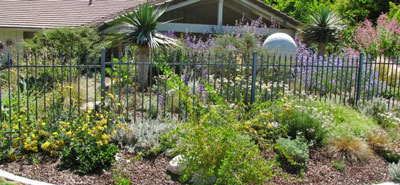
A Sustainable Approach to Water-Wise Landscaping
Xeriscape gardening offers a sustainable way to create vibrant, water-wise landscapes. Developed to reduce water usage, this approach uses drought-tolerant plants and efficient irrigation techniques to help you conserve resources without sacrificing beauty. The word “xeriscape” comes from the Greek prefix "xero," meaning dry, and "scape," meaning landscape. It was coined in the 1980s by the Denver Water Department to encourage residents to preserve water while still maintaining beautiful gardens.
Today, with an increasing emphasis on climate change, xeriscaping is about creating beautiful, functional gardens that work in harmony with your local climate. As weather patterns shift, xeriscape gardens that thrive with minimal water just make sense. Water isn’t an endless resource, so smart water management today ensures future generations have access to it.
The Benefits of Xeriscaping
- Water Conservation: Naturally reduces water consumption by up to 75%.
- Reduced Maintenance: Less need for fertilizers and pesticides, saving time and effort.
- Environmental Harmony: Supports local ecosystems by using native plants adapted to your area's natural rainfall.
- Cost Efficiency: Lower water bills and reduced landscaping costs. Xeriscaping may even eliminate the need for an irrigation system.
- Aesthetic Diversity: Xeriscape gardens can be colorful and visually appealing, not just gravel and cacti.
- Personal Satisfaction: Join a growing movement of gardeners making a difference, one garden at a time.
How Best to Get it Done!
1. Site Analysis
Design your xeriscape landscape with water efficiency in mind. Observe how much sunlight different parts of your yard get and the type of soil you have. Consider dividing your landscape into hydro-zones based on water needs:
- Oasis Zone: High water-use plants, usually near the house or in containers for easy manual watering.
- Transition Zone: Moderate water-use plants. Place these within hose reach for occasional watering.
- Arid Zone: Low water-use plants, best for the outer edges of your garden. Native plants may still need extra water in severe droughts.
You can create as few or as many hydro-zones as your landscape requires.
2. Soil Improvement
Healthy soil is key to a successful xeriscape garden. Test your soil's pH and nutrient levels using an inexpensive soil tester. Most soils will benefit from adding compost or aged manure to improve water retention. For clay-heavy soils, mix in sand or gypsum to improve drainage. Sandy soils will hold moisture better with added organic material.
3. Efficient Irrigation
- Use water-efficient systems like drip irrigation or soaker hoses, which target plant roots directly and reduce water waste.
- A manual timer ensures you don't accidentally leave the water on. More advanced "smart" controllers adjust watering based on weather conditions.
- Water early in the morning or late in the evening to reduce evaporation.
- Consider installing rain barrels to capture natural rainfall for your plants.
4. Select Drought-Tolerant or Native Plants
Choose plants adapted to your local climate. Native plants are a great choice as they typically thrive with minimal water. Popular xeriscape plants include:
- Succulents and Cacti: Aloe Vera, Echeveria, Agave.
- Native Shrubs and Trees: Sagebrush, Desert Willow, Mesquite.
- Ornamental Grasses: Blue Oat Grass, Buffalo Grass.
- Mediterranean Herbs: Lavender, Thyme, Rosemary.
These plants not only conserve water but also add texture, color, and visual interest to your garden.
5. Mulching
Mulch is crucial for retaining moisture and suppressing weeds in xeriscape gardens. Apply a 2-4 inch layer of organic mulch (like wood chips) or inorganic mulch (like gravel). Organic mulches decompose and enrich the soil but require occasional replacement. Inorganic mulches last longer but don’t provide nutrients. You can also use living groundcovers, such as creeping thyme, to help retain moisture.
6. Hardscaping
Incorporate hardscaping elements like pavers, gravel pathways, and natural rock to reduce water needs and add structure to your garden. Locally sourced materials can create patios, walkways, and retaining walls, allowing rainwater to permeate the ground.
7. Maintenance
Once established, xeriscape gardens are low-maintenance. Regularly prune shrubs, refresh mulch as needed, and occasionally weed. Check irrigation systems periodically to ensure efficiency. Seasonal tasks like reducing water in the cooler months will keep your garden thriving.
Common Challenges and Solutions
- Clay or Sandy Soil: Amend with organic matter or use raised beds for better water retention and drainage.
- Steep Slopes: Use terraces or drought-tolerant ground covers to prevent erosion and maximize water efficiency.
- Extreme Heat: Provide shade with heat-tolerant plants or use structures like pergolas or shade cloths.
- Wildlife Damage: Choose critter-resistant plants or use physical barriers.
- Rocky Yards: Consider raised garden beds if cultivating the ground proves difficult.
Case Studies in Xeriscape Gardening
Residential Transformation: A family in California replaced their lawn with a vibrant xeriscape garden. Native plants and a water-permeable patio led to a 60% reduction in water use and an increase in local biodiversity.

Commercial Office Park in Phoenix, AZ: Rainwater harvesting and native tree groves helped reduce water consumption by 80% and significantly lowered maintenance costs.

Public Library Demonstration Garden: A xeriscape garden at a Denver library showcased water-wise techniques, inspiring community-wide adoption of xeriscaping.

The Future of Water-Wise Landscaping
Whether you live in a drought-prone area or simply want to reduce water usage, xeriscaping is a practical and beautiful solution. It’s more than a trend—it’s a sustainable practice that conserves water, reduces maintenance, and supports resilient landscapes. By choosing the right plants, improving soil quality, and using efficient irrigation methods, you can create a thriving, eco-friendly garden that stands the test of time and helps preserve our planet's precious water resources.





























































































































































































































































































































































































































































































































































































































































